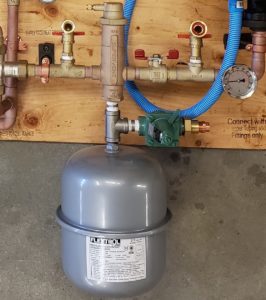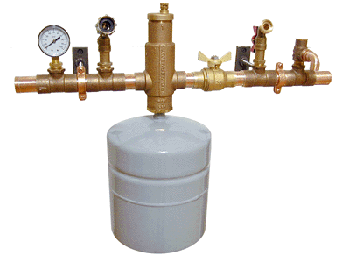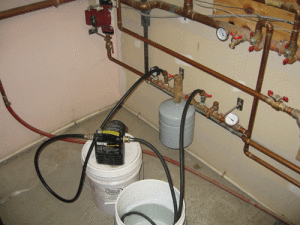Air trapped within a closed radiant system is the most common cause of inefficient system performance. Fortunately, it’s an easy problem to solve and won’t become an issue at all if care is taken during the initial filling process.
Take a moment to study the Expansion and Purge Kit . Hot water enters, travels through the Expansion and Purge Kit (EPK) and enters the Zone Manifold. From there, the water is drawn by the circulator pumps, through each individual zone, then back to the heat source. A closed system circulates the same fluid around and around, and is completely separate from the domestic water supply.
You will notice that there are three valves on the Expansion and Purge Kit…two boiler valves and a ball valve. The first boiler valve is located to the left of the expansion tank. For the sake of this description, we’ll call this the fill valve.
The second boiler valve (to the right of the expansion tank) we’ll call the drain valve. It is used to evacuate air from the radiant system.
Please note that either of these valves can act as fill or drain. Which function the valve serves depends upon whether the pump or pumps are located to the right or left of the EPK. In other words, you always want to fill the system in the direction of the circulator pumps.
Between the drain and fill valves is a shut off valve. Closing this valve during the filling process will force the water introduced into the fill valve to travel past the pumps, through the floor tubing, into the hot water heater or boiler, then out the drain valve. The close proximity of the drain and fill valves to each other guarantees no air pockets in the system.
A multi-zone closed system should be filled one zone at a time, and if the individual circuits within each zone are valved, purge one circuit at a time. The idea is to focus the water pressure as specifically as possible.
Using the ball valves located before each circulator pump on each zone, close off every zone but #1. Next, attach a garden hose to the drain valve and run it to a convenient sink, floor drain, outside, or wherever you want many gallons of discharge water to go.
An additional step that many installers find useful is to place a 5-gallon bucket in one of the above locations and let the water overflow out of the bucket before entering the drain. The advantage to this method is the visual indication of air bubbles. Often, the stream of water coming from the discharge hose looks purged of air — simply because the hose has stopped spitting and sputtering. But I can assure you that plenty of air remains. By holding the end of the discharge hose under water in the 5-gallon bucket, stray bubbles are impossible to miss.
- Close the shut off valve.
- Attach a second garden hose to the fill valve. We’ve included a brass female to female hose thread fitting to make it easy to connect the male end of your garden hose to this valve. This fitting can be used on either of the boiler valves, depending upon which of the two becomes the fill valve.
- You are now ready to purge the air out of zone #1.
- Using full house pressure or a powerful utility pump, flood the zone.
If you are using a new or empty tank-type water heater, you’ll be filling the tank during this procedure as well, so expect zone #1 to take the longest to fill. Any remaining zones will only be flushing air out of the floor tubing and the process will be much faster.
Observe the drain hose. Depending upon how large your hot water tank is, several minutes can pass without any water whatsoever discharging from the drain line….only air. Eventually, water will begin flowing, often in spurts and sputters. Be patient. Remember, a steady stream of water doesn’t necessarily mean that all the air is out of the system. A good rule of thumb is: once it seems that all the air is out of the zone, let a continuous stream of water flow one minute for every 100 feet of tubing in the zone. Sometimes, water can actually flow around a pocket of air, especially in a radiant system where many curves and bends are normal. However, given a few minutes of water flow, even the most stubborn bubble will break up and flow out the discharge hose.
It’s also a good idea to listen carefully to the water flowing through the system. In a floor joist system, quite often, as the water passes through the floor the air pockets are audible as they pass through the tubing. In a slab installation, the initial water and air emerging from the slab into the return manifold is quite noisy. Also, listen for any sounds coming from the water heater. Your goal is silence. In a properly charged radiant system, no sound whatsoever is audible.
You may also want to run your zone pump during this point of the procedure. If any air is trapped in the impeller, the force of the water now flushing the system will dislodge it. You only need to run the pump for a few seconds to accomplish this. And remember, cast iron circulator pumps are so quiet you have to touch them to know they’re on. Stainless steel pumps emit a very slight, nearly inaudible hum. In either case, if your pumps are noisy, then air is present.
So, when the water is flowing steadily out the drain hose and all audible indications of air in the zone have stopped, you’re ready to repeat the procedure with the remaining zones.
Open the ball valve before zone pump #2, and close the ball valve before zone pump #1.
Remember to allow at least one minute of water flow per 100 feet of tubing in the zone and, as in zone #1, be certain that all audible indications of air are absent.
When, after several minutes, the water is flowing steadily from the drain hose, close the valve before zone pump #2 and open the valve before zone pump #3.
Repeat this procedure for all remaining zones.
The last step, once all the zones are flushed, is to close the drain valve on the Expansion and Purge Kit and observe the pressure gauge. As soon as you close the drain valve, the pressure from the incoming water will begin pressurizing the radiant floor system. When the pressure gauge reads 15 psi, close the fill valve. This is your cold system pressure. When the system is hot the pressure will be a few psi higher. A positive pressure in the system will guarantee that any remaining air in the tubing, or any gassing off during normal operation will be purged by the air eliminator.
The cap on the air eliminator is closed when it is tightened (clockwise) and opened when the cap is backed off (counterclockwise) a few turns, so that daylight is visible through the slit in the cap,…The air eliminator cap may be removed if you wish, but is not necessary. When filling the system with liquid, the air eliminator’s cap can be either in the open or closed position. Pressure testing the system with air requires that cap to be closed so that it doesn’t release air ,…as that is it’s purpose. It is most important that the cap is opened for the duration of the system’s operation.
Note: The cap on top of the air eliminator should always be open during normal operation.
Open the shut off valve between the fill and drain valve.
Your heat source is now ready for firing.

Option for maintaining system pressure. Closed Radiant heating system equipped with an automatic fill valve. This low pressure valve will maintain a constant minimum pressure once the system is filled & purged.
Filling a Closed System with Anti-Freeze

Filling a single zone closed system with Electro boiler
The above procedure can be followed to eliminate all air from the system. Alternately, a utility transfer pump — not a sump pump — can be used to pump fluid into the system and evacuate the air. We recommend a powerful utility pump like the Wayne EC-50, or the Wayne PC-4, or an equivalent pump like the Utilitech .5 HP Cast Iron Transfer Pump, all of which can generate up to 45-psi.
So, whether you use a pump or house pressure to remove the air, one additional step is required.
Determine how much Propylene Glycol (not automotive Ethylene Glycol) anti-freeze your system requires by adding the total amount of fluid in the tubing (2.7 gallons per 100 ft. of 7/8″ Poly …1.3 gallons per 100ft of 1/2″ Pex) plus the volume of water in the hot water heater or boiler.
Determine what percentage of anti-freeze to water mixture is recommended by the manufacture of the heat source. Some recommend 30 % anti-freeze, other’s 50%. The proper mix is also influenced by the degree of low temperature you wish to protect against. Always pre-mix your anti-freeze before pumping it into your system!
Once the proper amount of pre-mixed anti-freeze has been calculated, place your first few gallons into a clean five-gallon bucket and use the utility pump to pump it into the system. Continually replenish the five-gallon bucket with your pre-mixed anti-freeze.
All the valves before all zone pumps should be open. This will help diffuse the anti-freeze evenly through each zone. When the anti-freeze is gone, close the drain valve.
If the radiant system had been filled with pure water to eliminate the air, the addition of the anti-freeze will displace a corresponding amount of water out the drain hose. Later, when the system is running, the Zone Manifold (in the case of a Heat Exchanger system) or the storage tank (in a standard Closed System) will act as a “mixing station”, further blending the anti-freeze with any remaining pure water that may be left in the system.
The final step is to pressurize the system. If you don’t have a powerful utility pump, reconnect the house supply to the fill valve (remember to flood the garden hose with water before reconnecting to the fill valve. This will avoid injecting air from the hose into the system), pressurize to 15 psi, then close the fill valve.
Your heat source is ready for firing.
By the way, some anti-freeze is already pre-mixed, others are in concentrate form. Be sure to check the label before adding water.


